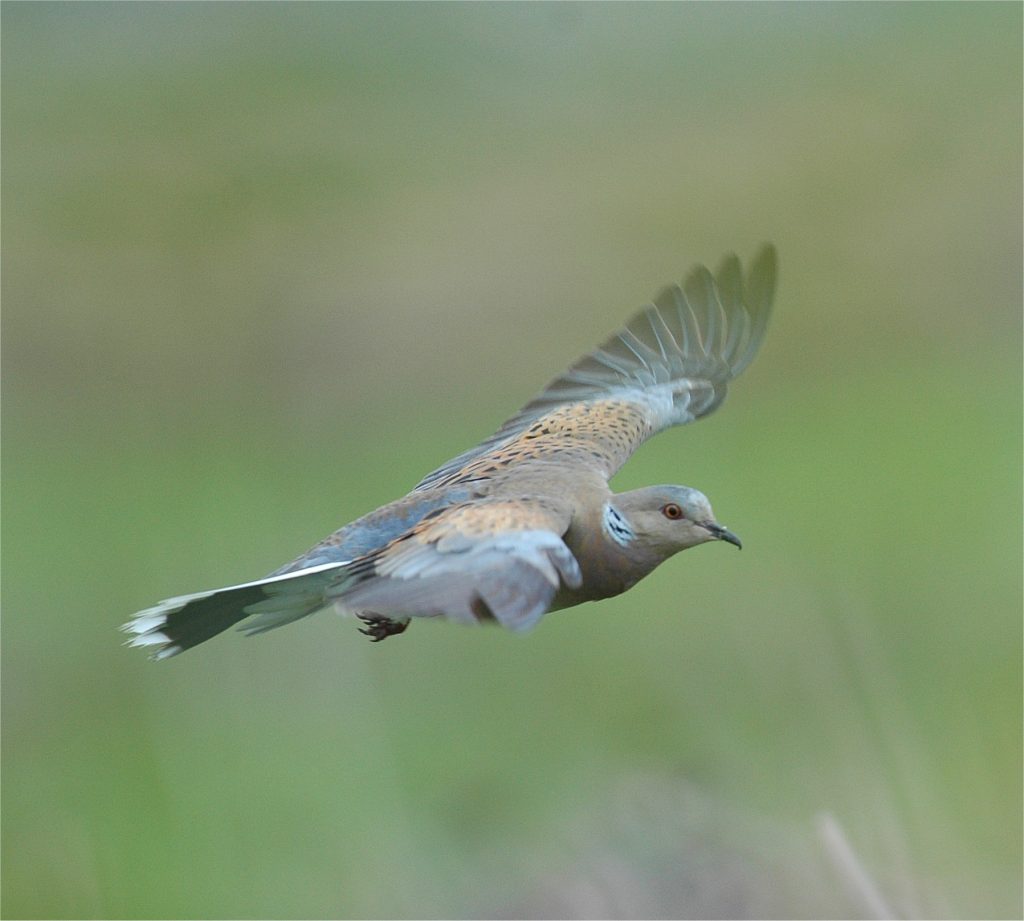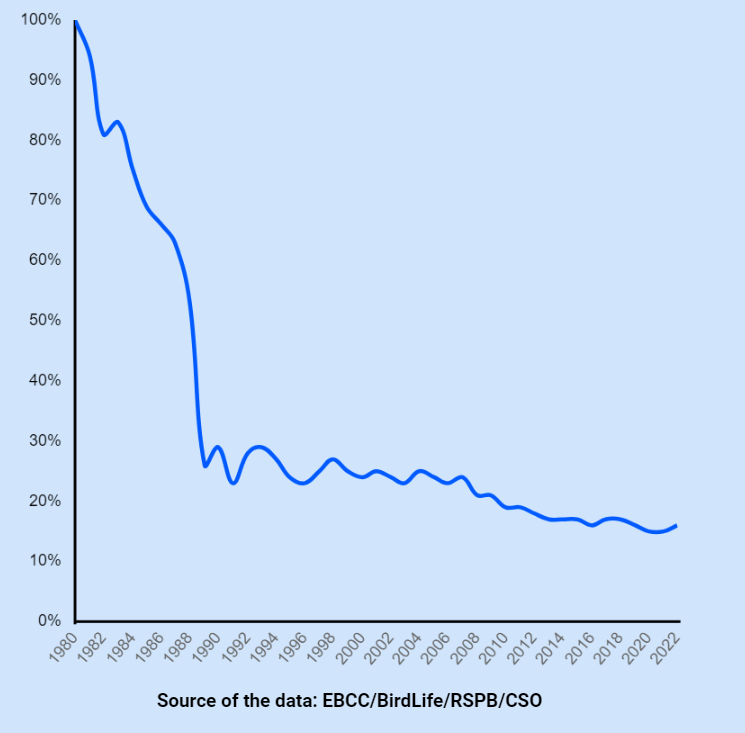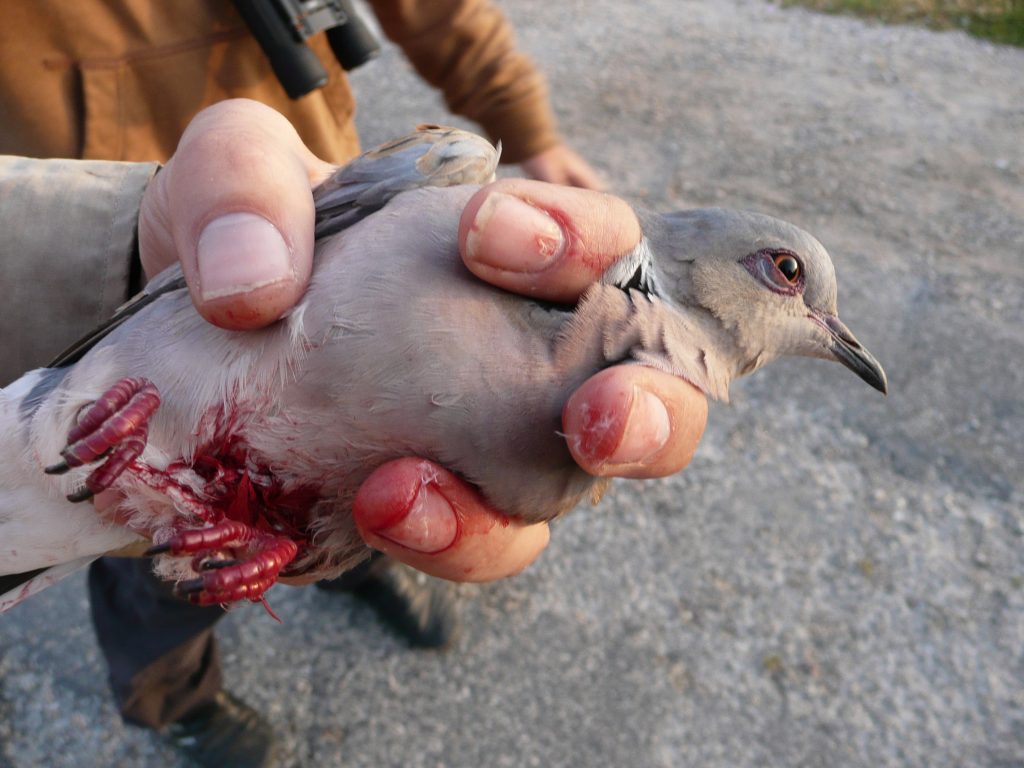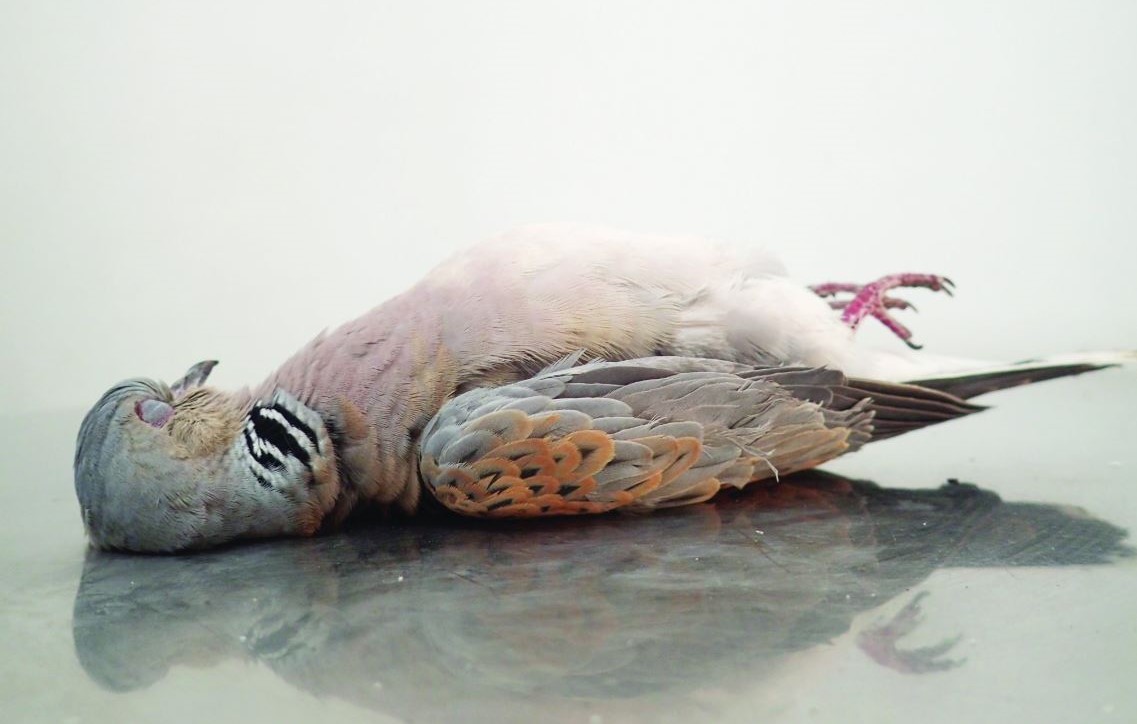Migratory bird of the month: Turtle‑dove

A long-distance flyer, the Turtle-dove migrates between its European breeding grounds and Africa’s vast Sahel belt. Flying mostly at night, the bird can cover up to 700km without stopping. The journey is dangerous, and the greatest threats come from humans.
Key info
- Latin name: Streptopelia turtur
- IUCN status (Europe): Vulnerable [1]
- Global population: The global population size is estimated at 12,800,000-47,600,000 mature individuals. In Europe, the breeding population is estimated to number 3,150,000-5,940,000 pairs, which equates to 6,310,000-11,900,000 mature individuals. [2]
- Migration Route: African-Eurasian flyway
Description
- Wingspan: 47–53 cm
- Life span: Up to 4-5 years
- Distinct features: The European Turtle-dove has a gentle purring song and distinct, scaly-patterned feathers on its wings. The black and white patch on the side of the neck is absent on juvenile birds.
- Favourite food: Primarily seeds and grains
- Top Speed: Up to 60 km/h
- Habitat: Open woodland, forest edges, hedgerows, and farmlands. Favours habitats where woodland and farmland meet.

Flight for Survival
A long-distance flyer, the Turtle-dove migrates between its European breeding grounds and Africa’s vast Sahel belt. Flying mostly at night, the bird can cover up to 700km without stopping. The journey is dangerous, and the greatest threats come from humans.
The European Turtle-dove, classified as ‘Vulnerable’ by the IUCN, is facing alarming population declines. In the past two decades, European populations have plummeted by 30-40%, with some countries witnessing staggering declines of over 90% since 1994![3] The main culprit behind this decline is extreme habitat loss due to intensive farming practices. The increased use of pesticides and herbicides and in farming reduce the abundance of seeds, the primary food source for the doves, and pose a risk of direct poisoning.
On top of this, the Turtle-dove faces the threat of illegal shooting, particularly in the Mediterranean, where many birds are unlawfully hunted or trapped. The bird is especially targeted by hunters and poachers due to its fast, sporty flight. Hunting Turtle-doves during their breeding season is forbidden by EU law, yet the problem persists across many parts of the Mediterranean. In Greece, gunshots often shower upon the Turtle-dove as it stops to rest on the Ionian Islands, exhausted after an epic flight over desert and sea. More than 70 000 Turtle-doves are estimated to be slaughtered there each spring, making it one of the worst blackspots along the African-Eurasian flyway.
The European Turtle-dove has become a symbol of the broader environmental challenges that migratory birds face. BirdLife emphasizes the need for international cooperation to protect these birds along their entire migratory route.

BirdLife’s work
As the Turtle-dove population has plummeted, the European Commission has recommended a temporary pause on hunting until the species recovers. They have supported the development of the Adaptive Harvest Management Model (AHMM) to determine sustainable hunting levels based on scientific data. Unfortunately, not all EU countries adhere to these recommendations. The Maltese government has, once again, opened a spring hunting season, allowing hunters to shoot birds returning to their breeding grounds, in addition to the autumn season. BirdLife Malta tirelessly fights against spring hunting, which violates the EU’s Birds Directive.

To study the bird better, BirdLife Malta also tagged eight Turtle-doves with satellite tags weighing only 5 grams between 2016 and 2020. These tags transmit the precise location of the birds via satellite. Currently, three of these tagged birds – Francesco (tagged in spring 2017), and Hope and Virginijus (tagged in May 2020) – are still transmitting. You can follow their movements here.
To learn more about how the BirdLife Partnership is working to stop the illegal killing of birds, visit our dedicated page.
Our Partner in the UK, the RSPB, focusses on enhancing breeding sites and reducing hunting along their migratory route through their project “Operation Turtle-dove”. They collaborate with partners and communities to create suitable habitats, including flower-rich feeding areas, accessible water, and good quality scrub and hedgerow nesting habitats. In 2023, they established 230 hectares of prime feeding habitat with the help of 370 farmers and land managers.
Interesting facts
Love birds
In many European countries, the European Turtle-dove has long represented love and fidelity. The strong bond between mating pairs has been a symbol of devoted lovers since the Renaissance, inspiring poetry, art, and song – including the works of Shakespeare. The dove is known for its gentle purring song (hence the Latin name “turtur”), which is a characteristic sound of the summer countryside. This soft cooing is not just pleasant to the ear; it also plays a crucial role in mating and territorial defence.
Nurturing nature
As granivores, the European Turtle-doves primarily feed on seeds and grains. Their diet plays a crucial role in the dispersal of various plant species, contributing to the health and diversity of their ecosystems. During breeding, they produce a nutritious milk-like substance called ‘crop milk’. Both parents feed this rich substance to their young while they are still in the nest, ensuring they receive the essential nutrients they need to grow.
Swift drinkers
Turtle-doves, along with the rest of the pigeon and dove family, are among the rare bird species that can suck up liquid through their beaks like a straw, instead of tilting their heads back to let gravity do the work. According to a study that used X-ray videos of pigeons, these birds pump their tongues like pistons to create a suction process similar to a vacuum pump. This unique drinking method allows doves to drink quickly, minimizing their exposure to predators.
- [1] BirdLife International. 2021. European Red List of Birds. Compiled by BirdLife International. Luxembourg: Publications Office of the European Union.
- [2] BirdLife International (2024) Species factsheet: Streptopelia turtur. Downloaded from https://datazone.birdlife.org/species/factsheet/european-turtle-dove-streptopelia-turtur on 28/05/2024.
- [3] Population trends for Turtle Dove in the UK and England | JNCC – Adviser to Government on Nature Conservation
Cover photo by Ben Andrew
You might be interested in:
 | Stichting BirdLife Europe gratefully acknowledges financial support from the European Commission. All content and opinions expressed on these pages are solely those of Stichting BirdLife Europe. The European Commission is not responsible for any use that may be made of the information it contains. |









